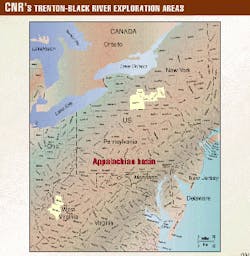A deeper play for gas in Ordovician Trenton-Black River is commanding attention in the Appalachian basin.
Columbia Natural Resources Inc., Charleston, W.Va., will drill two more wildcats by yearend and at least 12 next year to Ordovician Trenton-Black River in West Virginia.
Both of the wells CNR has drilled in Roane County, W.Va., "penetrated the Trenton-Black River formation and encountered natural gas flows at pressures considered extraordinary in the Appalachian basin," the company said.
But the heart of the play lies far to the northeast in the Finger Lakes region of western New York State, where Columbia has established production from the same formation in numerous wells.
What remains to be discovered in the 350 miles of basin separating these two areas is the subject of considerable speculation among operators in the basin.
CNR said it will continue to aggressively explore the area, where it has more than 2.6 million acres of mineral holdings.
Petroleum Technology Transfer Council and West Virginia University will hold a focused technology workshop Nov. 11 in Morgantown, W.Va., covering geology, exploration, drilling, completion, and production aspects of the Trenton-Black River Group.
West Virginia action
Columbia announced completion in mid-October of a second well in Cottontree field, Roane County, near its June 1999 discovery.
The discovery well demonstrated an open flow rate estimated at 50 MMcfd of gas as it was flared during wellhead installation.
Bottomhole pressure has held at 6,600 psi through the first month of full production.
The second well encountered a natural flow of gas at 9,630 ft in the top of the target formation and has characteristics similar in many respects to the discovery, CNR said. It is also among the basin's deepest producing intervals.
Columbia said it is working to determine the size and operational characteristics of Cottontree field, near Clio about 35 miles northeast of CNR headquarters in Charleston.
"Completing this confirmation well and making pipeline connections will provide us with the information needed to fully estimate the magnitude of this discovery," said Jack Watson, CNR vice-president of operations.
Columbia in early November was completing construction of an 8-in. gathering system to serve the two wells. It was to install surface equipment to allow the two wells to feed directly into a nearby Columbia Gas Transmission high-pressure interstate pipeline.
The company has staked location for an 11,600 ft Ordovician test in Kanawha County, just south of Roane County.
New York activity
CNR said that the geologic characteristics of the West Virginia wells appear analogous to prospects the company has developed in the same formation in a sub-basin in western New York state, where it has established production from 28 wells and has a 70% success rate.
In that area the company has drilled in Cortland, Schuyler, Steuben, Tompkins, and Yates counties, and producing depths are at about 7,500 ft.
Other operators are just joining the action. Pennsylvania General, a Warren, Pa., independent, staked a 10,300 ft Trenton wildcat last month in Steuben County. The spot is 5 miles north of Corning, N.Y.
CNR said its overall program in the Appalachian basin includes drilling 230 wells during 1999 and improving pipeline capacity.
The company this year completed acquisition of 800 wells and reserves in Kentucky and New York, and its Canadian production affiliate acquired additional properties and established two joint ventures in the Canadian Maritimes (see map, OGJ, Sept. 6, 1999, p. 72).



